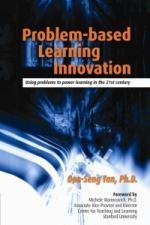Problem based Learning Innovation Using problems to power learning in the 21st century 1st Edition by Oon Seng Tan ISBN 9812437177 9789812437174 by Oon-seng Tan 9812437177 instant download after payment.
Problem based Learning Innovation Using problems to power learning in the 21st century 1st Edition by Oon Seng Tan - Ebook PDF Instant Download/Delivery: 9812437177, 9789812437174
Full download Problem based Learning Innovation Using problems to power learning in the 21st century 1st Edition after payment

Product details:
ISBN 10: 9812437177
ISBN 13: 9789812437174
Author: Oon Seng Tan
Problem based Learning Innovation Using problems to power learning in the 21st century 1st Table of contents:
Part I: The Foundations of Problem-Based Learning Innovation
Chapter 1: Understanding Problem-Based Learning: A Deeper Dive
- Historical Roots and Evolution of PBL
- Key Characteristics of Effective PBL
- Contrasting PBL with Project-Based Learning and Inquiry-Based Learning
- The Role of the Learner: Active Engagement and Self-Direction
- The Role of the Facilitator: Guiding, Not Telling
- Cognitive and Motivational Benefits of PBL
Chapter 2: The Science Behind Problem-Powered Learning
- Constructivism and Learning Theory
- Cognitive Load Theory and Scaffolding in PBL
- Motivation and Engagement: The Power of Authenticity
- Developing Critical Thinking and Problem-Solving Skills
- Fostering Collaboration and Communication
- Neuroscientific Perspectives on Learning Through Challenge
Chapter 3: 21st-Century Skills and the PBL Nexus
- Defining 21st-Century Skills: The 4 Cs (Critical Thinking, Communication, Collaboration, Creativity)
- Digital Literacy and Information Fluency in PBL
- Adaptability, Resilience, and Growth Mindset
- Global Citizenship and Intercultural Competence
- How PBL Naturally Cultivates These Essential Skills
- Future-Proofing Learners for an Unpredictable World
Part II: Designing Innovative Problem-Based Learning Experiences
Chapter 4: Crafting Compelling Problems: The Heart of PBL
- Characteristics of a Good PBL Problem (Ill-structured, Authentic, Engaging, Complex)
- Sources of Problems: Real-World Scenarios, Case Studies, Current Events
- Problem Design Process: From Topic to Trigger
- Varying Problem Types for Different Learning Goals
- Scaffolding the Problem: Providing Just Enough Information
- Examples Across Disciplines (K-12, Higher Ed, Corporate Training)
Chapter 5: Curriculum Design for PBL Innovation
- Integrating PBL into Existing Curricula
- Developing New PBL Units or Courses
- Mapping Problems to Learning Objectives and Competencies
- Sequencing Problems for Progressive Skill Development
- Cross-Disciplinary PBL Approaches
- Ensuring Alignment with Standards and Frameworks
Chapter 6: Assessment in a Problem-Based Learning Environment
- Shifting from Traditional Assessment to Authentic Assessment
- Formative Assessment Strategies in PBL (Observations, Checklists, Peer Feedback)
- Summative Assessment of Knowledge, Skills, and Processes
- Rubrics for Critical Thinking, Collaboration, and Problem-Solving
- Self-Assessment and Reflection as Integral Components
- Technology-Enhanced Assessment Tools for PBL
Part III: Implementing and Facilitating Innovative PBL
Chapter 7: The Facilitator's Role: Guiding the Learning Journey
- Preparing for Facilitation: Content Knowledge vs. Process Expertise
- Essential Facilitation Skills: Questioning, Listening, Group Management
- Fostering a Safe and Supportive Learning Environment
- Managing Group Dynamics and Conflict Resolution
- When to Intervene and When to Step Back
- Strategies for Providing Effective Feedback
Chapter 8: Cultivating Collaboration and Teamwork
- Forming Effective PBL Teams
- Establishing Group Norms and Responsibilities
- Strategies for Productive Group Work (e.g., Roles, Tools)
- Addressing Common Group Challenges (e.g., Free-Riding, Dominance)
- Teaching and Assessing Collaborative Skills Explicitly
- Virtual Collaboration Tools for PBL
Chapter 9: Integrating Technology for Enhanced PBL
- Tools for Research and Information Gathering
- Collaboration Platforms (e.g., Google Workspace, Microsoft Teams, dedicated LMS features)
- Presentation and Communication Tools
- Simulation and Virtual Reality in PBL
- Data Analysis and Visualization Tools
- Ethical Use of Technology in Problem-Solving
Part IV: Overcoming Challenges and Scaling PBL Innovation
Chapter 10: Addressing Common Challenges in PBL Implementation
- Time Constraints and Curriculum Demands
- Student Resistance and Initial Discomfort
- Managing Resources (Information, Materials, Expertise)
- Ensuring Content Coverage vs. Deep Learning
- Measuring Impact and Demonstrating Value
- Gaining Buy-in from Stakeholders (Parents, Administrators)
Chapter 11: Scaling PBL Innovation: From Classroom to Institution
- Professional Development for PBL Facilitators
- Building a Culture of Problem-Based Learning
- Administrative Support and Resource Allocation
- Advocating for PBL: Demonstrating Success and ROI
- Creating Learning Communities for PBL Practitioners
- Implementing PBL in Different Educational Contexts (K-12, Higher Ed, Corporate)
Chapter 12: The Future of Problem-Based Learning
- PBL and AI: Augmenting Learning Experiences
- Personalization and Adaptive PBL Paths
- Global Collaboration and Cross-Cultural Problem-Solving
- The Role of PBL in Competency-Based Education
- Research Agendas for PBL Innovation
- The Continued Evolution of Problem-Powered Learning
Conclusion: Empowering the Next Generation of Problem Solvers
- Recapping the Core Tenets of PBL Innovation
- The Transformative Potential for Learners and Educators
- Final Thoughts on Sustaining a Culture of Inquiry
Appendices
- A. Sample PBL Problem Templates
- B. Rubrics for Assessing 21st-Century Skills in PBL
- C. Recommended Digital Tools for PBL
- D. Further Reading and Resources
People also search for Problem based Learning Innovation Using problems to power learning in the 21st century 1st:
problem based learning innovation
what is problem-based learning
problem based learning examples
what is problem-based learning in education
problem based learning technology
Tags: Oon Seng Tan, Problem, Innovation



